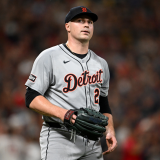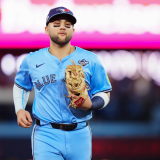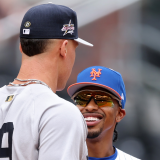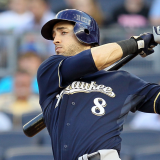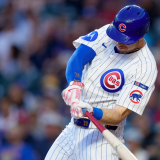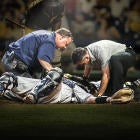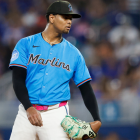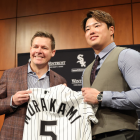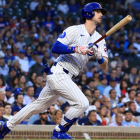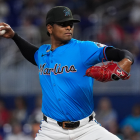The year of catcher concussions and MLB's battle to do better with head trauma
Baseball isn't football, but concussions remain part of a catcher's job all the same
In September 2011, in the embers of an otherwise forgettable game between the Detroit Tigers and the Chicago White Sox, A.J. Pierzynski laced a pitch into catcher Alex Avila's face. The ball struck Avila's mask at the speed and angle necessary to generate sparks. Everyone remembers the fireworks. That's why "The Early Show" replayed the clip the next morning, and that's why the play remains hosted all over YouTube, on Major League Baseball's official channel and other channels who, presumably, lack baseball's express written consent:
Watching the scene unfold in 2017 is a surreal experience. The announcers' "look' at that!" giddiness strikes the wrong note from the jump. Then there's unsettling visual of Avila's head snapping back, which didn't seem to move either the Tigers' trainer to check in on Avila, or Detroit's manager to remove Avila from the game. The most shameful reaction to the play isn't portrayed in the clip: that would be the public address system blaring "Ring My Bell" in an uncaring nod that, yeah, Avila had probably been concussed moments prior -- but so what?
In the six years since, some things have changed. The world and professional sports have become more cognizant of concussions and their ill effects. One thing that has not changed, however, is the potential for a catcher to suffer a brain injury on any given pitch.
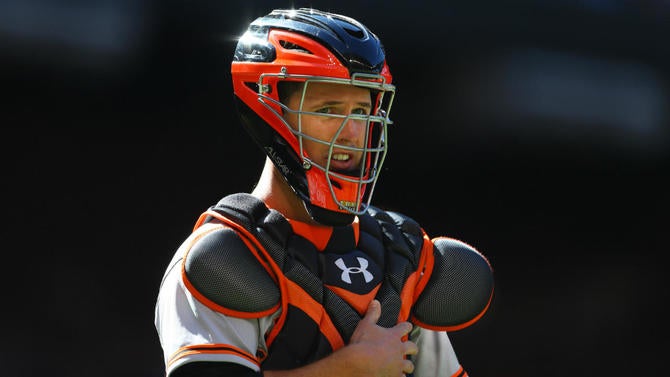
The year of the concussed catcher
Baseball's concussion history is often overlooked for obvious reasons -- it's not as salacious or as extensive as those held by contact sports like football and hockey. Though there are numerous cases of ruined careers or misshaped fates. Be it Joe Mauer, Justin Morneau, Pete Reiser, Jason LaRue, Corey Koskie, John Jaso, Jason Bay, or Ryan Freel, whose brain showed signs of chronic traumatic encephalopathy (CTE) -- to be concussed repeatedly in baseball is to run ashore on some bad luck. Or, well, to play catcher. That's why those guys, to quote a top concussion expert, tend to be "the ruggedest of the rugged." Why else would they willingly man a position requiring protective equipment nicknamed "the tools of ignorance?"
What's happening today with concussions in baseball has been overlooked, too. You wouldn't know it, but this has been the year of the concussed catcher. Entering September, 11 backstops had required a disabled list stint due to a concussion, according to Corey Dawkins of Baseball Injury Consultants. The previous two seasons yielded nine such cases. Combined. In the past two weeks alone, both Yadier Molina and Bruce Maxwell have left games after taking repeated foul tips to the head.
Dawkins' comprehensive database stretches back to 2006. In the dozen years he's captured, catchers have been deactivated due to concussions 77 times. The other part of the battery, pitchers, have hit the DL because of a concussion 13 times. The sight of a pitcher getting laid out by a line drive is understandably more jarring -- at least catchers have some protection -- but those incidents are rare, and stand out more because of their infrequency. Conversely, fans are so accustomed to seeing catchers thwacked by foul tips and whacked on backswings that only the worst of the worst rent space in the public's mind.
"It's just one of those byproducts of catching," former big-league backstop Rob Bowen told CBS Sports. Bowen caught nearly 200 major-league games during his playing days. "You're going to take your dings, you're going to take your hits, you're going to get balls off the mask."
The one thing catchers are taking less of these days is the same thing that caused Bowen to ask out of a game for the first and only time in his career: a home-plate collision.
Baseball instituted the Buster Posey Rule following the 2013 season as a means of reducing how often catchers were bowled over by baserunners. That the Posey Rule hasn't eliminated or suppressed concussion totals isn't surprising -- most of that damage occurs on foul tips. Even so, the Posey Rule has kept backstops from suffering unnecessary harm -- and, as a result, has almost certainly prevented some brain trauma.
Buck Martinez caught in the majors for 17 seasons, and later managed the Toronto Blue Jays before moving into their broadcast booth. An outspoken critic of the Posey Rule, Martinez nonetheless shares tales of playing on after being knocked out by aggressive runners, and concedes he's likely suffered several concussions. The kicker is Martinez didn't learn about them from a doctor or a trainer. He learned about concussions -- literally the term, as well as the ramifications -- from the stories of catchers Matt Walbeck and Mike Matheny, the St. Louis Cardinals manager whose concussion history forced him into retirement. Notably, neither Walbeck nor Matheny were Martinez's contemporaries -- Martinez played his final game in October 1986, while Walbeck and Matheny debuted in the majors more than six years later.
Baseball effectively moved from allowing unconscious catchers to play on to forcing early retirements in six-plus years. It's fair to write, then, that improved knowledge is partially responsible for the uptick in concussions. In other words, well-informed catchers are ostensibly more likely to report concussion-like symptoms to the training staff, rather than gutting through it. (As Bowen put it, "Ah, don't worry about it, I'm tough, I'll just take some Advil.") Modern teams are probably more likely to place those players on the disabled list, given there's a seven-day version specifically for concussions. Together, with some variance sprinkled in, those factors explain some of the increase in concussed catchers.
Still, there could be other, less-encouraging factors at play, too: like changes to the gear and the game.
To wit, Bowen and Martinez each identified the hockey goalie-style mask as a potential contributor. The goalie mask is lighter and offers better vision than the traditional "two-piece" mask -- that's the one umpires usually wear. But, from the ex-catchers' perspective, the goalie mask features less structural integrity and protection. A bad combination in the face of foul tips.
"There's just a very, very light, thin pad that's right there at the chin, and there's really not a whole lot of padding toward your forehead," Bowen said. "You look at a traditional two-piece mask, that had a little bit heavier metal that was involved with it, and you see how thick the pads were that were wrapped around the bottom of the jaw and the top, toward your forehead. The heavier metal, to me, seemed like it would absorb something a little bit better against your face, because you have so much padding before it got to your face."
Martinez noted that, while the old two-piece masks were heavier, they came with cages that would bend to absorb the ball's energy -- thereby sparing the catcher's head from the brunt of the blow. Titanium masks were also fingered as a plausible negative. Coincidentally, Minnesota Twins catcher Jason Castro recently swapped out his titanium mask for a magnesium one after dealing with a concussion borne from foul tips.
Obviously catchers can control what style of headgear they use. But they can't control how the game changes around them. Martinez thinks those alterations could be a catalyst. "Because pitchers are throwing so hard now, I think there are probably more foul balls, foul tips, than we've ever seen," he said. "The velocity of the pitchers, the bats are harder, the baseballs are certainly harder. I think it's all led to a multiple amount of concussions over the last several years."
Whether or not Martinez's theories are correct doesn't much matter. The hunt for bigger, stronger, faster is programmed into sports as an evolutionary mechanism. Luckily, "the tools of ignorance" are becoming more sophisticated themselves. There's a new mask that's forging its reputation each and every time it protects an unexpected face.

The catcher bringing change
Since joining the Atlanta Braves in December of 2015, Tyler Flowers has enjoyed the two best years of his career. In fact, Flowers has been the most productive catcher in the majors this season, according to Baseball Prospectus' Win Above Replacement Player -- a one-stop-shop metric that gives him credit for his excellence at framing pitches.
Before Flowers signed with the Braves as their starting catcher, he took on a new responsibility: part owner of Force3 Pro Gear.
Flowers' foray into the equipment business started the way most do: with a meeting. Prior to a game at Fenway Park between Flowers' White Sox and the Boston Red Sox, Flowers and Ryan Hanigan (they share an agent) were introduced to Jason Klein, Force3's founder. Klein pitched the two on his best product, the Defender mask, which had received rave reviews from umpires and had scored well in independent testing -- Klein had the results on hand to prove it.
"We're confident in what we claim, because we have scientific data that backs up what we're doing," Klein told CBS Sports, "which is reducing an impact." Klein is no scientist and doesn't purport to be one. His knowledge of concussions and gear comes from his experience and research, and he's careful with his words. Klein doesn't claim the Defender mask can stop concussions -- just that testing verifies it lessens the force placed on the catcher's head.
Flowers bought in after Klein's sales pitch, and soon become part owner of Force3 in lieu of financial compensation for wearing the Defender. The unusual arrangement -- and yes, the league is aware of it, as well as the Defender -- is one Flowers values, as it affords him a more hands-on role. When Flowers began wearing the Defender, Klein and crew had to alter the dimensions -- they were so used to fitting umpires that the Defender had to be taken out so it could comfortably fit around a helmet as well as a ballcap.
What makes the Defender mask unique is its unusual, spring-loaded design that absorbs shocks. "It's really logical, and it's kind of baffling that nobody came up with this idea before," Flowers said. He compared the mask's structure to a car's suspension system, explaining that the Defender comprises two masks: an outer one (the part exposed to foul tips) and an inner one (the part with padding). The two are connected by the spring system. "When the outer mask is impacted, the springs compress and absorb the majority of the energy; it rebounds," Flowers said. "You feel just a little bit of it. But the reduction is remarkable."
Tyler Flowers is setting the stage for catcher’s safety. #Braves C breaks down his gear for Chopcast LIVE’s @coryjmccartney, @Zach_Dillardpic.twitter.com/vSl71TeO9k
— FOX Sports: Braves (@FOXSportsBraves) July 23, 2017
Klein's unique background prepared him for this role. The son of an engineer and metallurgist, he spent 10 years umpiring in the minors. In 2007, he started trying to improve umpire equipment in a meaningful way -- not just slap a new logo on the same old gear, as he says. After five years of development, the Defender mask was ready for action. To prove it, Klein paid three different labs to test the Defender against competitor's masks. The Defender scored well, sometimes too well. "We had two test facilities that wouldn't even certify their results because they thought their machines were broken," Klein said.
Klein provided CBS Sports with reports from NTS Chesapeake, a ballistics testing laboratory located in Maryland. The Defender did indeed score better than other masks in measures like "severity index," just one of a few metrics wielded to narrow the gap between physical testing and medical data, according to project manager Chris Peitsch. Peitsch explained that they primarily use "drop" and "impact" testing -- the former involves dropping the mask from a certain height, the latter shooting baseballs at the mask at certain speeds. Both are designed to quantify things like deceleration. "You want to stretch that out as long as you can," Peitsch said. "You don't want a really quick deceleration, because that's what causes concussions, the brain moving too fast to stop."
The guidelines followed by labs like NTS Chesapeake are those provided by the National Operating Committee on Standards for Athletic Equipment's (NOCSAE). Somewhat concerningly, there is no standard test for the two-piece mask -- only the goalie style. Additionally, companies are obligated to test their equipment at speeds of 87 mph, per MLB's request. Force3 is among those who push higher, in search of better understanding and results.
From Flowers' squat -- and he has reason to be biased -- the Defender seems to perform as well on the field as in the laboratory. "I've probably taken six or seven square shots where the ball ends up in front of me, and I would equate it, to the old mask that I've worn, as a glance that goes all the way to the backstop." Others are becoming believers, too.
Klein told CBS Sports that Los Angeles Dodgers catcher Yasmani Grandal had recently terminated his contract with Nike, and will be a member of the Force3 team heading forward on a deal that's like Flowers' -- right down to part ownership of the company.
Klein ballparked that eight other big-league catchers wear the Defender (Kurt Suzuki, Austin Hedges, and Matt Wieters among them), in addition to some umpires. The Braves bought a fleet of Defender masks for their minor-league catchers independent of Flowers, and at least a few other teams have recommended their prospects wear the Defender for as long as they're in the system (including the San Diego Padres, who have seen both Hedges and Hector Sanchez miss time this year with concussions). Flowers, who admits he's weary of abusing his privilege as a big-league player by promoting the Defender too much, expects more catchers to give it a go -- likely after a "come to Jesus" moment.
"Unfortunately, you don't take it all that serious until you find yourself in the midst of some sort of issue," Flowers said. "That's been the case with a lot of the catchers who have started to wear it -- they experience a concussion or something close to it that lets them know they need to take it a little more serious, then they end up reaching out to us and switching over."
Although Flowers has never been diagnosed with a concussion, he believes he's had a few -- from catching, and from playing fullback and linebacker in high school, as he wasn't the kind to run around his opponents. Flowers knows how painful taking a direct shot to the mask can be all the same. "One time in the minors, I couldn't eat any kind of meat for like two weeks, just because my jaw was clicking and sore and it hurt," he said. "I had to start wearing a mouthpiece for those couple weeks, just hoping that it wouldn't get worse. Those days are far behind me."
But what about catchers who have had concussions -- what lies ahead for them?

What's at stake
The wildest thing about the play that caused Avila's mask to spark is that he was not diagnosed with a concussion. Part of the surprise is rooted in hindsight. In the years since, Avila has become synonymous with the dangers of the position (he's made three trips to the DL due to concussions or related symptoms). He's continued to catch following equipment changes and an altered stance behind the dish to help him better evade foul tips. People have continued to ask: should Avila hang up his gear in the interest of preserving his long-term health?
It's an important question, for Avila and any catcher who has dealt with head trauma. Unfortunately, satisfying answers are hard to come by.
What is known for certain is that baseball is not a contact-heavy sport, like football or hockey. Think about it this way: a baseball, even one traveling at a high speed, has a smaller mass than an opponent's body; foul tips can and do inflict damage but, relatively speaking, the brain is less likely to be dramatically shaken at contact than on a tackle -- in part because there's not a rotational aspect, forcing the head and neck to twist. Football has gotten hammered for concussions, and for good reason. A recent Boston University study that examined 111 brains belonging to former National League Football players found that 110 of them had CTE. Baseball's math isn't as frightening -- Freel was the first ballplayer known to have CTE.
Beyond that, there's a lot of uncertainty with concussions -- and a lot of misconceptions.
"Our work at BU has not correlated well the number of concussions with one's risk for CTE," said Dr. Robert Cantu, who is the vice president of NOCSAE, a clinical professor of neurology and neurosurgery, and a co-founder of the CTE Center at the Boston University School of Medicine. "Instead, what's correlated best, is total brain trauma exposure. The number of years you've played a sport at high risk, for both subconcussive blows and concussive blows, the greater your chance of having later-in-life neurodegenerative issues."
The term "subconcussive" isn't feared as much as its more intense sister, yet it merits concern. Dr. Cantu noted that "roughly 20 percent" of BU's CTE cases belonged to athletes who had no recognized concussions. Those athletes had instead played sports at a high risk of head trauma for a long time. Alas, the tricky reality is that no matter how many concussive or subconcussive hits one takes, nobody can say for certain when or how those will affect an individual.
"Getting a ton of concussion and subconcussive brain trauma is like pulling the trigger in Russian roulette," said Alan Schwarz, who covered both baseball and concussions for the New York Times. "The chamber might be empty, and you might be OK, What are you going to blame life or death on? Are you going to blame it on the trigger -- or are you going to blame it on the presence of the bullet?"

That same variability exists in other respects. Not all concussions are created equal, and not everyone heals the same way. Inevitably, that leads to disagreement on the proper post-concussion treatment, with some experts preferring a more conservative approach."We're making the mistakes of the past," said Dr. Bennet Omalu, who discovered CTE. Omalu's findings were documented in the film "Concussion," starring Will Smith. "Because the brain damage is done inside the skull, nobody sees it. We don't take it as seriously as we would if it's something we see, like a laceration or fracture of your leg."
Dr. Omalu called the seven-day DL "a joke," noting that the brain remains inflamed a week after a concussion occurs. Teams, he reasoned, should sit concussed players for much longer periods, perhaps as long as three months. Alternatively, Dr. Cantu said that while everyone is different, roughly 80 percent of people have their symptoms clear up within seven to 10 days.
Is it any wonder why this is a difficult, complicated issue? Nonetheless, it's an important one -- one every catcher will deal with to some extent. "You would certainly expect that a player playing a lot of the months of a year, like a professional would be playing, would be concussed at least once or twice over a five-year period -- if not more," Dr. Cantu said. "Whether they recognized it as a concussion, that's probably another matter."
Stamping out catcher concussions is probably an unrealistic endeavor -- at least as the game is constructed. Major League Baseball deserves credit for taking positive steps toward preventing and treating them in recent years: reducing home-plate collisions; instituting the seven-day DL (created in conjunction with medical experts); mandating a concussion protocol. All are pluses. The key heading forward is continuing to encourage all players, and especially catchers, to override the part of their brain that tells them it's okay to play on after taking a nasty hit to the head.
If baseball keeps educating players, and keeps providing incentive for teams to act appropriately -- and not to put their interests above their players' long-term well-being -- then perhaps everyone's reaction to the next Avila incident will be improved.
"I know the people who run baseball. I know them personally, I know them professionally, and they're very smart, caring people," Schwarz said. "It kills me when I see them lapse into this stupidity that other sports seem to thrive on."


